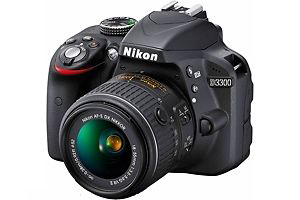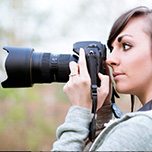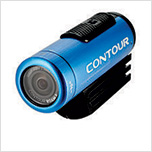Stepping up to a proper camera
If you’ve been getting into your photography using a compact camera or a smartphone, you might be ready to upgrade to a proper camera with interchangeable lenses. Having the ability to choose your lenses, means that you can chop and change for different situations, always producing the best-quality pictures. Indeed, photographers often say that you should spend more on the lenses than on the camera body to produce the best shots. Throw in full manual control over the camera’s settings and a proper camera will give you the ability to tune your shots to get some amazing results.
David Ludlow, Group Editor at Expert Reviews & Know Your Mobile, can help you find the model that suits your needs.and provides a nifty comparison table to help you decide the model for you.

NIKON D3300, £600
eBay loves: High resolution sensor, great controls
Watch out for: Images get noisy in low-light
Nikon’s entry-level DSLR is one of the highest-resolution models thanks to its 24-megapixel sensor. Some clever engineering ensures that detail is amazing. With Nikon’s excellent manual controls and access to a wide range of lenses, the D3300 is a great way for anyone to get into photography.

CANON EOS 700D, £600
eBay loves: Quick auto-focus, great image quality and brilliant controls
Watch out for: The kit lens isn’t great
Canon’s entry-level DSLR manages to take everything the previous model did and improve upon it. Now the EOS 700D can create the kind of sublime images we’d expect from a Canon camera. Excellent and fast auto-focus, combined with a wide-range of lenses means that this is the perfect consumer-orientated budget camera.

PANASONIC GF6, £400
eBay loves: Small size, great price and brilliant image quality
Watch out for: Kit lens is comparatively large
This compact-sized CSC is the perfect high-quality camera that you can happily carry everywhere with you. Its articulated touchscreen flips out and can be adjusted, making it easy to compose shots from any angle. With excellent image quality and a brilliant video mode, it’s a great choice
| Nikon D3300 | Canon EOS 700D | Panasonic GF6 | |
| Sensor size | DSLR | DSLR | Compact CSC |
| Sensor resolution | 24-megapixels | 18-megapixels | 16-megapixels |
| Sensor crop factor | 1.5X | 1.6X | 2X |
| Lens mount | Nikon F-Mount | Canon EF | Micro 4/3 |
| LCD size & resolution | 3in (921,000 pixels) | 3in (1,040,000 pixels) | 3in (1,040,000 pixels) |
| Viewfinder | Yes (optical) | Yes (optical) | No |
| Battery life | 500 shots | 440 shots | 330 shots |
| Weight | 505g | 785g | 439g |
| Size | 96mm 125mm 77mm |
111mm 134mm 151mm |
65mm 112mm 97mm |
DSLR or CSC?
When it comes down to choosing a camera with interchangeable lenses, you’ve got the choice of a Digital Single Lens Reflex (DSLR) or a Compact System Camera (CSC).
The two are roughly similar in terms of features, providing full manual control, but there are a few crucial differences. A DSLR gets its name from the mirror that sits in front of the sensor (the reflex mirror). Light passes through the lens, bounces off the mirror and reflects into a pentaprism in the viewfinder, which means that you can see directly through the lens.
When you take a photo the mirror flips up out of the way, exposing the sensor and letting light fall onto it. The mirror also moves out of the way in live view mode where you compose shots using the camera’s screen.
A CSC does away with the mirror, with light falling directly onto the sensor. Shots can only be composed using the camera’s screen, although some have an electronic viewfinder (EVF), which adds a second screen viewable through a viewfinder.
Many people find composing and focussing easier with a DSLR, as the view is exactly as you see with your eyes. With a CSC you’re looking at a screen to do everything. In particular, this can make it hard to manually focus, as it’s not always evident when everything is sharp.
As a trade-off, CSCs are both lighter and smaller than DSLRs, as there’s no complex mirror assembly inside. You can get CSCs in a wide-variety of sizes, from compact-sized cameras all the way up to almost-DSLR-sized (but lighter) models. Generally speaking, larger models are easier to operate, because they have more manual controls within easy reach, but are obviously harder to transport.
Sensor size
Physical sensor size has an impact on all types of camera, helping to define both quality and the area of the scene that’s captured in your photographs. At the high-end, full-frame DSLRs have a digital sensor that’s the same size as 35mm frame, as used in old film cameras. Any lens put on a full-frame DSLR camera has the same field of view as if it were used on a film camera.
Full frame cameras are expensive, as the sensors are expensive to make, so consumer cameras tend to have smaller sensors. These have a narrower field of view to full-frame cameras, so using the same lens your shots appear to be more zoomed in.
The reason for this is easy to understand if you think of the sensor as a window. Looking out of a 35mm window, you might have a great view of the outside world; looking out of a 25mm window, you’d get a much narrower, cropped, view of the world.
As a result, DSLR and CSC cameras have a crop factor, such as 1.5x. You multiply the crop factor by the lens’ focal length to get that camera’s true focal length, and how much of a scene it would capture. For example, a 35mm lens on a sensor with a 1.5X crop factor acts like a 52.5mm lens would on a full frame camera.
With lenses the smaller the focal length (quoted in mm), the more wide-angle it is; the larger the focal length the higher the zoom. So, in our example, a full-frame camera with a 35mm lens can take some nice wide-angle shots; but on our 1.5x crop factor camera, its focal length of 52.5mm is more zoomed in and close to regular human vision for field of view.
What this means in practice is that consumer cameras find it harder to get wide-angle shots, but telephoto lenses are easier to make. Consumer DSLR cameras use APS-C sensors, which have a 1.5x or 1.6x crop factor. Most CSCs use smaller sensors, still, with a crop factor of 2x common.
Sensor size is also important for another reason: light. The larger the sensor the more light the camera can capture. More light generally means better image quality, better low-light performance and less noise. That’s just a rule of thumb, as a brand-new CSC with a small sensor will perform better than an older DSLR with a larger sensor.
Resolution
A camera’s resolution is measured in megapixels (one million pixels). The larger the number, the more pixels you get in an image and the higher the resolution. Higher resolutions mean more detail is possible in an image, but it’s not always that straight forward.
Sensor size also has a part to play. With a larger sensor, you can squeeze more pixels on and still have a lot of light hitting each one; work with a small sensor at the same resolution and each pixel gets less light, which can have a negative effect on quality.
Again, each camera is different and quality can only be judged model-by-model. However, don’t buy a camera based on megapixels, as that alone tells you nothing. Typically, a consumer camera with a 16-megapixel sensor is a good starting point, with 24-megapixels available on some models.
Sensitivity
The sensitivity of a camera, measured as an ISO number, such as ISO800, describes how the camera can perform in low light. Quoted as a range, cameras that have a higher ISO range, can operate in low-light conditions, as the sensor’s sensitivity to light is boosted. Typically speaking, the higher the ISO setting you choose, the noisier the resulting photos. However, the quality of the camera’s sensor and its image processing make a big difference to the resulting photos.
Lenses
Of course, the main reason to buy one of these types of cameras is for the range of lenses. It’s a good rule that you should eventually spend more money on the lenses you use than the camera. It’s the quality of the lens that will affect image quality more than anything. Lenses have to be bought for your particular camera, as each one has its own unique mount.
Most cameras are available with a kit lens, which gives you a decent zoom range (at least 3x). These are general-purposes lenses suitable for most situations. However, quality tends to be mediocre at best.
When you can, you should start to upgrade your lenses. Generally speaking, avoid lenses with massive zoom ranges. These might sound great, but it’s hard to make a lens that produces quality shots all the way through a large range; besides, if you want this, you should buy a cheaper bridge camera that has a big lens built-in.
Instead, you want a range of lenses, suitable for different situations. All lenses have a focal length written on them, in mm. The lower the number, the more wide-angle it is; the higher the number, the bigger the zoom. Prime lenses have one focal length and produce stunning pictures; those with zooms quote two focal lengths: the starting wide-angle position and the maximum zoom. All focal lengths are quoted as if used on a 35mm film camera, so don’t forget, you have to multiply the focal lengths by the camera’s crop factor.
Lenses also quote the aperture range as an F-number, such as f/2.8. The smaller the number, the larger the aperture, which means more light passes through the lens. This is useful for capturing fast-moving subjects and for low-light situations. Larger apertures mean that less of the frame is in focus, which is great for blurring the background in portrait shots.
Smaller apertures let less light through, which means more of the frame is in focus, but you’re more likely to get motion blur. Small apertures can also be used for some great effects, as you can use a long exposure to capture a river, for example, giving the water a silky effect.
The type of lens you pick will depend on what you want to shoot, but as a rough guide you should think about the following. A 50mm prime is great for shooting portraits. A general-purpose lens (say 17-50mm) is great for every-day. A wide-angle lens (say 10-20mm) is perfect for landscapes. A telephoto lens (say 70-300mm) is great for wildlife. There’s a huge choice of lenses out there, and we can’t go into all of the detail here.
Typically speaking, DSLR cameras have a choice of more lenses from a wider-range of manufacturers. You’ll also find a great choice of focal lengths. The trade-off is that these lenses tend to be bigger and heavier, and can be more expensive.
DSLR lenses created for APS-C sensors are cheaper than the equivalent lens designed for full frame cameras. This is because they use less glass. However, you can use a full frame lens on an APS-C camera, but not the other way round.
Battery Life
Battery life is an important consideration. As DSLRs let you compose and focus through the lens, their screens don’t have to be turned on all of the time. This gives them a massive advantage in terms of battery life. With a CSC, the screen is used for everything, so you’ll find that you’ll need to charge them more often and, most likely, carry a spare battery with you.
See Also

Choosing the perfect compact camera

Stepping up to a proper camera

Action Camera
Buyer's Guide
